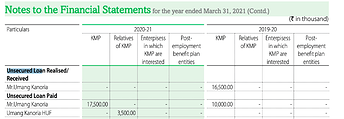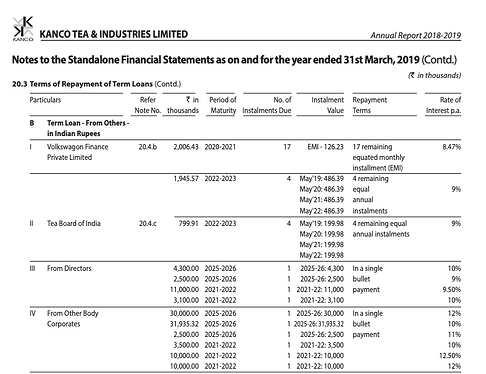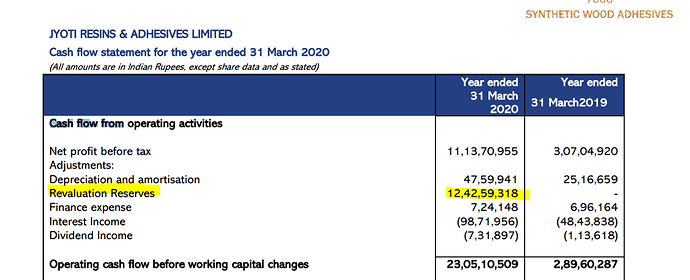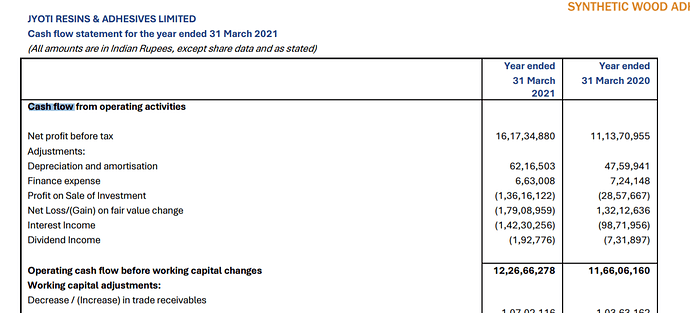Hi
How do we know which are the important ratios for a particular industry ?
For eg - For retail sector/industry - Inventory turnover cycle can be a important ratio to look at ?
except - P/E, current ratio , quick ratio
Check its credit rating report and search its methodology.
This is very generic. Please mention the industry of interest. The reason behind this answer is, there may be 100s of industry and there might be some similarities among fields also. Please be specific which field or company you are looking, that will help for better answering this question.
We have websites like moneycontrol, screener,in to check the financial aspect of the stock.
Do we have reliable websites/sources to check the following
-
Management of the company
-
Industry overview for the future
Apologies if it’s already been asked somewhere.
Hi
There used to one table in one of the Annexures in the earlier Annual reports which shows debt of the company paid/borrowed in the financial year, I am unable to find that in this year AR, also no share holders list with more than 1% share holding and their transactions, any idea why these are not visible in this AR now??
Like this from PI industries 2018 AR:
I assume you joined “https://forum.valuepickr.com/” for stock research/analysis details…this is the best source for the details you are looking for…
search for the stock you want to understand and read the posts.
Some times the details may be hidden in several posts, so need to read through all.
you can also search in google, you may find some blogs…
but you may not find much for small/micro cap stocks…Valuepickr…may be best source.
check this one
I found below snapshot in Related Party Transaction in Annual Report

What does below sections means
- Unsecured Loan Realised/Received - Does this refer to amount Company has taken loan from this person
- Unsecured Loan Paid - Does this refer to loan person has obtained from company or it refer to repayment of loan by company to that person
Also, how can a person both give and receive loan at same time
From what I know, Paid means company has given a loan and Realised or Received means, company has got the loan back.
A person may have taken a loan the previous year or few years back and paid this FY, and again took a new loan this FY. You should check the previous years’ ARs to know more.
Also, You should post the complete image so that more members can look at it and provide answers, no matter how it looks.
The company is Kanco Tea & Industries Ltd
https://www.screener.in/company/541005/consolidated/
It is not at the same time, it would be at different points of time during the year. It is very common, especially in small promoter driven companies.
Thanks a lot for the inputs @barathmukhi and @Chandragupta . Referred to Earlier Annual Reports as suggested.
The company I am referring to is Kanco Tea & Industries Ltd .
Looks like Unsecured Loan Paid is actually repayment done by the company to the director
Director- Umang Kanoria gave loan of 11000 in FY19 and 16500 in FY 20 and it is paid as 10000 in FY20 and 17500 in FY21
Below screen shot of FY21 and FY20 shows loans taken and paid in
However in Notes to Balance Sheet, Loan section showed Interest rate of 11000 loan as 9.5% . However instalment amount as well actually repayment was exactly equal as load taken
What would this interest rate would refer to ?
The amount is 11000 but the table says that the amounts are in 1000’s.So the amount is 11,000,000 or 1.1 crore rupees.
He has given a loan 1.1 crore and 1.65 crore (total 2.75 crore) and got the same amount 1.75+1 = 2.75 crore.So basically he has not collected interest as yet and may do so in the future OR maybe he has forgone interest.
Either way the interest rate is 9.5 percent annual which is not excessive.
@Vaibhav_Gupta1 There are 2 very likely possibilities, both of which are turn offs as an investor or at least that’s how I tend to look at it.
1st possibility is that the promoter of a micro cap borrowed a small sum from the co. or
2nd possibility being that the the co borrowed from the promoter.
In most cases it is better to skip the co and move to something else rather than deep dive into something that has a remote chance of turning into something that can produce a meaningful return.
Sometimes it is better to put things into the “too hard” pile and just move on to something better in the interest of the limited time all of us have for investing 
If you’re still interested in the co, you may want to do a fund flow analysis for at least the last 5 years, using the method suggested here and then try to connect the dots.
If the promoter has lent to the company at 9.5%, there is no issue. This is fairly common in small and micro caps. It is much more efficient and faster for the promoter to fund temporary liquidity mismatches himself rather than the company making a formal loan application with a bank. In fact, it shows the promoter is committed to the business and is willing to put more money into it.
However, if the case is the reverse (company lending to the promoter), it is a red flag and it would be best to stay away from such companies.
Hi guys I am a complete newbie where I have started investing seriously for the last 2 months.
Currently, I can invest 10,000 every month. I have arrived at 18-20 stocks where I have done my research and have my conviction. What should be my strategy?
I am currently looking at companies from my shortlist where it is trading at a low RSI eg Caplin Point, Newgen, Acrysil I bought in the last 2 weeks, allocating the same percentage. I bought Max Health at 277. And also tracking stocks with high RSI so that I can enter them when price corrects.
For a long term investor should I be selling stocks much or just keep on adding no matter the price. For eg Max Health should I book a profit or add on to it even if price goes up to 430.
Please let me know how to build wealth from a small capital in a volatile market.
If the capital is less, you should gain experience in the initial years, take in your stride whatever market throws at you, both excesses and blows. You can invest any which way you like, if you do not expect anything in return except experience, because there is so much to learn.
Regarding buying and selling, have a plan. If you are a long term investor, focus on the business, build a position along with conviction, good companies don’t disappear in 5 years. If you are a trader, then you should have a preset target and stop loss, you can extend your time frame if you are in profit but not when you are in loss, trading is tough, the loss taking part. You could be both an investor and a trader at the same time, and can even trade in a core PF stock. To each his own.
My suggestion would be, to be active, learn, practice and gain experience. As with a lot of things, in the markets too, one gets better at the game with time.
The management is required to present the transactions with the related parties in the financial statement. Hence the presentation of loan raised and repaid are provided (as required by the applicable accounting standards). Also management is required to disclose the interest on the loan is paid or payable as at the year end. Any transaction with a related party must always be at arms length price and thus the % of interest is a critical disclosure to the readers of financial statement/ tax authorities. From a shareholder point of view, they can get to know the expected cash outflow on loan availed. @Vaibhav_Gupta1
Researching Modison metals these days. I came across a note in the notes to accounts section in the AR for the last 5 years consecutively, just wanted to understand what does this really mean and how to interpret such information.
Annual Report link: https://www.bseindia.com/bseplus/AnnualReport/506261/68840506261.pdf
Let us take an example here. The customer has placed an order for Silver at a rate of Rs. 120/kg whereas the company is valuing inventory at Rs. 100/kg as per their accounting policy. The silver which was booked by the customer was valued at Rs. 120/kg in their inventory instead of Rs. 100/kg.
And here, not in consonance means they did not follow the usual accounting policy for valuation.
Hope this helps.
I have doubt in tax calculation.
scenario 1:
After all deductions the taxable is 3 lakhs per annum which comes under 5% tax bracket. If I have STCG taxable amount of 10000 where I can add it in earnings and pay 5% tax or separate 15% has to be paid.
scenario 2:
After all deductions the taxable income is 2 lakhs per annum for which no tax. how STCG is considered in this scenario.
and explain LTCG in both scenario.
I have attached screenshots of the CFS of Jyoti Resins from AR20 and AR21, why has been the revaluation reserves entry been removed in AR21?
is this an accounting trick to actually inflate cash flow from operation activities to show better effeciency and then suddenly remove it in the next year AR?
Is this even allowed? This is very alarming.
I am not even commenting on the company and its promoters background. All I am really concerned about is how easily it can be deleted and left for the public to spot
is this normal?
Links: https://www.bseindia.com/bseplus/AnnualReport/514448/66215514448_01_10_20.pdf
https://www.bseindia.com/xml-data/corpfiling/AttachHis/b93157a0-d585-4d66-998d-f68cc8e131c1.pdf








